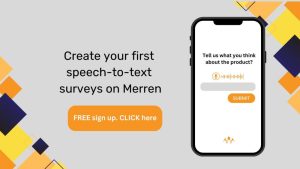Think about it. It is now easier to leave a voice note over texting. Sharing voice notes is faster and more personalized.WhatsApp has also reported that people send 7 billion voice messages on a daily basis. Voice note in customer feedback has just begun and it is here to stay. With the help of smart CX tools, marketers can transcribe
What Is A Speech to Text Survey?
Voice surveys are also called speech to text surveys. Voice survey allows respondents to answer questions by speaking instead of typing or selecting options. Participants say their answers out loud in a digital customer feedback form. A speech recognition technology converts their voice responses into written text during data analysis.
Survey distribution channels for voice surveys:
Survey channels such as WhatsApp , Facebook messenger and web Chatbots are compatible to capture audio responses. Marketers can create customer satisfaction metrics and include an open ended section for qualitative response. Seek audio responses from people and get media rich insights from your customers.
What are The Advantages Of Speech To Text Surveys?
Modern day CX tools are capable of creating transcripts of audio responses. Here are the advantages of using speech to text surveys.
1. Higher response rate from customers:
People find it cognitively easier to share voice notes over traditional survey formats. It is user friendly and highly engaging in nature. This interactive manner of sharing feedback encourages people to give their honest opinions of experiences. This brings a high response rate and meaningful data.
2. Higher accessibility among certain respondents:
Speech to text surveys are a feasible solution for people who have certain disabilities or senior citizens (older adults). This format of communication removes technical barriers. They can use audio notes to share their experiences in their own language. Additionally, people can send voice messages without having to log in to a computer. They can do it on the go, practically anywhere.
3. Get media rich data with details:
Audio survey captures more than what text cannot. When respondents share voice notes, the CX dashboard can capture media rich feedback. This includes, nuances, emotions and sentiments, tones, spoken language etc. This offers deeper insights on our customer base compared to a text-only approach.
4. Multilingual capacity of speech to text tools:
Speech to text features can support many popular languages spoken globally. This feature is ideal where customers are diverse. CX professionals can curate geographically appropriate customer feedback forms and bring audio messages to the CX dashboard. Respondents can answer in their native tongue.

5. Compatible with fast survey distribution channels:
WhatsApp and Facebook messenger survey channels are superfast in nature. Marketers can curate customer feedback forms and seek audio messages for feedback. WhatsApp, Facebook messenger and chatbots have the capacity to handle millions of messages on a daily basis. Additionally, AI powered chatbots can handle complex customer messages. This is an efficient way to gather more data with superfast survey distribution channels.
6. Close feedback loop with real time data transcription:
CX dashboards can grasp real time data be it audio messages of customer satisfaction metrics. The same dashboard can transcribe audio messages at the same time. This enables the customer service team to close the feedback loop at the earliest. While the transcription may be automated, a manual intervention can personalize solutions for respective grievances.

7. Cost effective and allocate resources aptly:
Since audio transcriptions are automated, organisations need not allocate manual intervention. This prevents batch-processing of data in situations where timing is critical. Automatic transcription can prevent online damage of reputation where people demand resolution at the earliest. Speech to text surveys are easier to deploy irrespective of the same size. Hence brands can allocate their resources at touchpoints that may need more attention.
8. Compatible across devices and greater reach:
Voice messages are compatible on almost every mobile device. It is also compatible with android and iOS platforms. Speech to text technology comes inbuilt as a feature in every phone. Hence CX professionals can get more information from people and make data-driven decisions.
Speech To Text Responses For Digital Diary
Digital diary is a medium where people share their daily experiences with the organisation. They record their thoughts via voice messages. This is useful for FMCG products that need constant feedback from their customer base. Digital diary depends on voice and video messages to collect customer feedback. Using Merren CX tools, marketers can deploy feedback forms for digital diary at certain touchpoints. Use superfast mediums of WhatsApp survey and Facebook messenger to collect media rich responses.
Conclusion
Speech to text is useful for multiple applications. Spanning from market research to customer advocacy, audio messages can help us gauge inside the mind of a respondent. This offers a more personalized way of catering to the customer base. Audio messages help us understand people’s tone, sentiments and expressions. This media rich format can help brands communicate with their consumer base better.To start creating your own customer feedback survey, sign up for a 14 day free trial with Merren. Convert audio messages into smart transcripts instantly.

